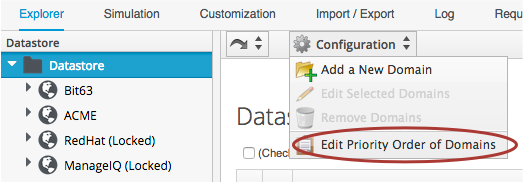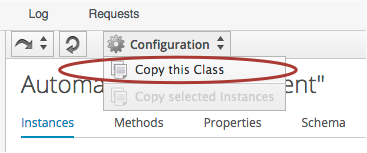Domains and Namespaces
Domains
A Domain is a collection of Namespaces, Classes, Instances and Methods. The ManageIQ project provides a single ManageIQ Domain for all supplied automation code, while Red Hat adds the supplemental RedHat Domain containing added-value code for the CloudForms product.

Both the ManageIQ and RedHat Domains are locked, indicating their read-only nature, however we can create new Domains for our own custom automation code. Organising our own code into custom Domains greatly simplifies the task of exporting and importing code (simplifying code portability and re-use). It also leaves ManageIQ or Red Hat free to update the locked Domains through minor releases without fear of overwriting our customisations.
Domain Priority
User-added Domains can be individually enabled or disabled, and all Domains can be layered in a priority order such that if code exists in the same path in multiple Domains (for example /Infrastructure/VM/Provisioning/StateMachines/Methods), the code in the highest priority enabled Domain will be executed.

Importing / Exporting Domains
Domains can be exported using rake from the command line, and imported either using rake or from the WebUI. (Using rake enables us to specify more import and export options). A typical rake import line is as follows:
bin/rake evm:automate:import YAML_FILE=Buttons.yaml IMPORT_AS=Bit63 \
SYSTEM=false ENABLED=true DOMAIN=Export PREVIEW=false
See the following kbase articles for details and examples of importing and exporting Domains using rake:
Cloudforms 3.1 Exporting Automate Domains
Cloudforms 3.1 Importing Automate Domains
Copying Objects Between Domains
We frequently need to customise code in the locked RedHat or ManageIQ Domains, for example when implementing our own custom VM Placement method. Fortunately we can easily copy any object from the locked Domains into our own, using Configuration -> Copy this ...


Importing Old Format Exports
Domains are a new feature of the Automation engine for the ManageIQ Anand release (CloudForms Management Engine 5.3). Prior to this release all factory-supplied and user-created automation code was contained in a common structure, which made updates difficult when any user-added code was introduced (the user-supplied modifications needed exporting and re-importing/merging whenever an automation update was released).
To import a Datastore backup from a 3.0 and prior format Datastore, it must be converted to the new Datastore format first, e.g.
cd /var/www/miq/vmdb
bin/rake evm:automate:convert FILE=database.xml DOMAIN=SAMPLE \
ZIP_FILE=/tmp/sample_converted.zip
See also...
Cloudforms 3.1 Automate Model Conversion
Namespaces
A Namespace is a folder-like container for Classes, Instances and Methods, and is purely used for organisational purposes. Namespaces can contain other Namespaces, as shown in the following diagram:

We create Namespaces to arrange our code logically.